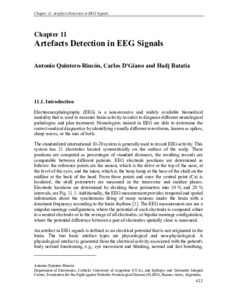Please use this identifier to cite or link to this item:
https://repositorio.uca.edu.ar/handle/123456789/13861| Título: | Artefacts Detection in EEG Signals | Autor: | Quintero-Rincón, Antonio D’Giano, Carlos Batatia, Hadj |
Palabras clave: | ELECTROENCEFALOGRAFIA; ACTIVIDAD NEURONAL; ENFERMEDAD CEREBRAL; DIAGNOSTICO POR IMAGEN; BIOMEDICINA; ELECTROFISIOLOGIA | Fecha de publicación: | 2021 | Cita: | Quintero-Rincón, A., D’Giano, C., Batatia, H. Artefacts Detection in EEG Signals [en línea]. En: Yurish, S. Y. Advances in signal processing : reviews book series, Vol.2. Barcelona : International Frequency Sensor Association Publishing, 2021 ISBN 978-84-09-28830-4. Disponible en: https://repositorio.uca.edu.ar/handle/123456789/13861 | Resumen: | Abstract: Electroencephalography (EEG) is a non-invasive and widely available biomedical modality that is used to measure brain activity in order to diagnose different neurological pathologies and plan treatment. Neurologists trained in EEG are able to determine the correct medical diagnostics by identifying visually different waveforms, known as spikes, sharp waves, or the mix of both. The standardized international 10-20 system is generally used to record EEG activity. This system has 21 electrodes located symmetrically on the surface of the scalp. These positions are computed as percentages of standard distances, the resulting records are comparable between different patients. EEG electrode positions are determined as follows: the reference points are the nasion, which is the delve at the top of the nose, at the level of the eyes; and the inion, which is the bony lump at the base of the skull on the midline at the back of the head. From these points and once the central point (Cz) is localized, the skull perimeters are measured in the transverse and median planes. Electrode locations are determined by dividing these perimeters into 10 % and 20 % intervals, see Fig. 11.1. Additionally, the EEG measurement provides temporal and spatial information about the synchronous firing of many neurons inside the brain with a dominant frequency according to the brain rhythms [1]. The EEG measurement can use a unipolar montage configuration, where the potential of each electrode is compared either to a neutral electrode or to the average of all electrodes; or bipolar montage configuration, where the potential difference between a pair of electrodes spatially close is measured. | URI: | https://repositorio.uca.edu.ar/handle/123456789/13861 | Disciplina: | INGENIERIA | Derechos: | Acceso abierto | Fuente: | Advances in signal processing : reviews book series, Vol.2. Barcelona : International Frequency Sensor Association Publishing, 2021 |
| Appears in Collections: | Libros/partes de libro |
Files in This Item:
| File | Description | Size | Format | |
|---|---|---|---|---|
| artefacts-detection-eeg-signals.pdf | 2,2 MB | Adobe PDF |  View/Open |
Page view(s)
94
checked on Apr 27, 2024
Download(s)
386
checked on Apr 27, 2024
Google ScholarTM
Check
This item is licensed under a Creative Commons License

